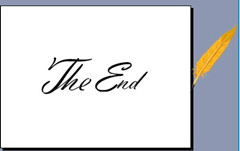优秀的essay离不开好的conclusion,然而很多同学在在主题部分描述的很整齐,但是结尾部分却没有好好斟酌,将读者的体验抛开了。大家可以阅读一些优秀的文章,通过观察作者的结尾部分可以发现,结尾一般都是意味深长,或者给大家留下思考空间。然而这些都是结果的写作技巧。通过以下4中常见的essay conclusion写作技巧,我相信你的essay水平能得到很大的提高。
As difficult as it is to begin a personal narrative essay, wrapping it up can be even more challenging. Writers often fall into the trap of tying the narrative up too neatly, telling the readers what they are supposed to take away from their story instead of letting the reader come to their own conclusions. Study a few essays from some of the great writers and notice how they conclude their stories. Often the ending to their narratives is left ambiguous; the reader isn’t exactly sure how everything will turn out; however, the reader should be left with a sense of closure.
Below are some strategies you might use to come to a satisfying conclusion in your own stories. All are final lines from some popular essays.
End with an Image
When nature essayist Scott Russell Sanders was in Omaha to talk to writing students, he said one of the most common problems for beginning writers when crafting a narrative essay is conclusions. He said his advice is always the same: if in doubt, end on an image. It’s foolproof. Showing an image prevents you from telling your feelings. In the essay “Buckeye,” Scott Russell Sanders uses the image of a grazing deer to conclude his narrative:
. . . within a few paces of a grazing deer, close enough to see the delicate lips, the twitching nostrils, the glossy, fathomless eyes.
This lyrical conclusion comes from “Bathing,” as writer Kathryn Winograd shows the last moments of her bath:
The wind sings through the window like a siren, and the steam floats from my skin like milk.
End with Action
Show yourself in action. Move. Do something, anything, to avoid telling the reader how happy, or sad, or hopeful you are in the end. Look at something, and walk away, as Edward Hoagland does in “The Courage of Turtles”:
But since, short of diving in after him, there was nothing I could do, I walked away.
Or look at something, and become mesmerized. A chapter from the classic memoir, Stop Time by Frank Conroy, “Yo-Yo Going Down, a Mad Squirrel Coming Up,” shows a young Conroy as he watches a girl through a window:
That same night, hidden in the greenery under the window, I watched a naked girl let down her long red hair.
End with Dialogue
Dialogue can be tricky to conclude with, but can work if it avoids a message or moral. You’ll only want to use this concluding technique if it has been maintained in the narrative; you probably don’t want to throw in spoken word if we haven’t heard anyone speak up until that point.
David Sedaris, in his essay, “Cyclops,” ends with the voice of his father, who is the main character in this essay:
“I don’t know where you got it from, but in the end, it’s going to kill you.”
The following brief reply, taken from Jo Ann Beard’s “The Fourth State of Matter,” shows an image, followed by unquoted dialogue. Beard uses italics instead:
Around my neck is the stone he brought me from Poland. I hold it out. Like this? I ask. Shards of fly wings, suspended in amber.
Exactly, he says.
Another example below comes again from Scott Russell Sanders, this from “Cloud Crossing,” as his toddler son babbles:
“Moon,” he is piping from the back seat, “moon, moon!”
End with Reflection
When used well, reflection is a great way to convey feelings without telling the reader how you felt – or how they should feel. Reflection offers the writer’s thoughts about what is happening or has happened. Reflection can include thoughts about the moment or thoughts looking back, about the experience. Reflection can add clarity, as we see the writer thinking through the experience. This concluding moment is from James Baldwin’s “Notes of a Native Son”:
. . . I wished that he had been beside me so that I could have searched his face for the answers which only the future would give me now.
Bret Lott, in his short essay, “Brothers,” reflects on childhood memories of his family, taking him into the present with his own two sons:
What I believe is this: That pinch was entry into our childhood; my arm around him, our smiling, is the proof of us two surfacing, alive but not unscathed.
And here are my own two boys, already embarked.
When writing your own conclusion, think about what you want your readers to take away from your story. Then think about how best you can show it. Ending with reflection may work great for one story, but not another. Concluding with dialogue may sound forced. You seldom can go wrong with images. Think about what feeling, emotion, or question you want to leave your readers with, the take-away, then pick the type of conclusion that best suits the piece. If you’ve done your job showing the event or experience throughout the narrative, the conclusion will come naturally.
上一篇


